Some may frown on the solution language being Python, but the aim of this is was to give some pointers (high level process). I haven't written R in a long time so Python was quicker.
EDIT: R script now added
General outline:
The first dropdown options can be grabbed from the value attribute of each node returned by using a css selector of #param571 option. This uses an id selector (#) to target the parent dropdown select element, and then option type selector in descendant combination, to specify the option tag elements within. The html to apply this selector combination to can be retrieved by an xhr request to the url you initially provided. You want a nodeList returned to iterate over; akin to applying selector with js document.querySelectorAll.
The page uses ajax POST requests to update the second dropdown based on your first dropdown choice. Your first dropdown choice determines the value of a parameter search[filter_enum_make], which is used in the POST request to the server. The subsequent response contains a list of the available options (it includes some case alternatives which can be trimmed out).
I captured the POST request by using fiddler. This showed me the request headers and params in the request body. Screenshot sample shown at end.
The simplest way to extract the options from the response text, IMO, is to regex the appropriate string out (I wouldn't normally recommend regex for working with html but in this case it serves us nicely). If you don't want to use regex, you can grab the relevant info from the data-facets attribute of the element with id body-container. For the non-regex version you need to handle unquoted nulls, and retrieve the inner dictionary whose key is filter_enum_model. I show a function re-write, at the end, to handle this.
The retrieved string is a string representation of a dictionary. This needs converting to an actual dictionary object which you can then extract the option values from. Edit: As R doesn't have a dictionary object a similar structure needs to be found. I will look at this when converting.
I create a user defined function, getOptions(), to return the options for each make. Each car make value comes from the list of possible items in the first dropdown. I loop those possible values, use the function to return a list of options for that make, and add those lists as values to a dictionary, results ,whose keys are the make of car. Again, for R an object with similar functionality to a python dictionary needs to be found.
That dictionary of lists needs converting to a dataframe which includes a transpose operation to make a tidy output of headers, which are the car makes, and columns underneath each header, which contain the associated models.
The whole thing can be written to csv at the end.
So, hopefully that gives you an idea of one way to achieve what you want. Perhaps someone else can use this to help write you a solution.
Python demonstration of this below:
import requests
from bs4 import BeautifulSoup as bs
import re
import ast
import pandas as pd
headers = {
'User-Agent' : 'Mozilla/5.0 (Windows NT 6.3; Win64; x64) AppleWebKit/537.36 (KHTML, like Gecko) Chrome/70.0.3538.102 Safari/537.36'
}
def getOptions(make): #function to return options based on make
data = {
'search[filter_enum_make]': make,
'search[dist]' : '5',
'search[category_id]' : '29'
}
r = requests.post('https://www.otomoto.pl/ajax/search/list/', data = data, headers = headers)
try:
# verify the regex here: https://regex101.com/r/emvqXs/1
data = re.search(r'"filter_enum_model":(.*),"new_used"', r.text ,flags=re.DOTALL).group(1) #regex to extract the string containing the models associated with the car make filter
aDict = ast.literal_eval(data) #convert string representation of dictionary to python dictionary
d = len({k.lower(): v for k, v in aDict.items()}.keys()) #find length of unique keys when accounting for case
dirtyList = list(aDict)[:d] #trim to unique values
cleanedList = [item for item in dirtyList if item != 'other' ] #remove 'other' as doesn't appear in dropdown
except:
cleanedList = [] # sometimes there are no associated values in 2nd dropdown
return cleanedList
r = requests.get('https://www.otomoto.pl/osobowe/')
soup = bs(r.content, 'lxml')
values = [item['value'] for item in soup.select('#param571 option') if item['value'] != '']
results = {}
# build a dictionary of lists to hold options for each make
for value in values:
results[value] = getOptions(value) #function call to return options based on make
# turn into a dataframe and transpose so each column header is the make and the options are listed below
df = pd.DataFrame.from_dict(results,orient='index').transpose()
#write to csv
df.to_csv(r'C:\Users\User\Desktop\Data.csv', sep=',', encoding='utf-8-sig',index = False )
Sample of csv output:

Example as sample json for alfa-romeo:

Example of regex match for alfa-romeo:
{"145":1,"146":1,"147":218,"155":1,"156":118,"159":559,"164":2,"166":39,"33":1,"Alfasud":2,"Brera":34,"Crosswagon":2,"GT":89,"GTV":7,"Giulia":251,"Giulietta":378,"Mito":224,"Spider":24,"Sportwagon":2,"Stelvio":242,"alfasud":2,"brera":34,"crosswagon":2,"giulia":251,"giulietta":378,"gt":89,"gtv":7,"mito":224,"spider":24,"sportwagon":2,"stelvio":242}
Example of the filter option list returned from function call with make parameter value alfa-romeo:
['145', '146', '147', '155', '156', '159', '164', '166', '33', 'Alfasud', 'Brera', 'Crosswagon', 'GT', 'GTV', 'Giulia', 'Giulietta', 'Mito', 'Spider', 'Sportwagon', 'Stelvio']
Sample of fiddler request:

Sample of ajax response html containing options:
<section id="body-container" class="om-offers-list"
data-facets='{"offer_seek":{"offer":2198},"private_business":{"business":1326,"private":872,"all":2198},"categories":{"29":2198,"161":953,"163":953},"categoriesParent":[],"filter_enum_model":{"145":1,"146":1,"147":219,"155":1,"156":116,"159":561,"164":2,"166":37,"33":1,"Alfasud":2,"Brera":34,"Crosswagon":2,"GT":88,"GTV":7,"Giulia":251,"Giulietta":380,"Mito":226,"Spider":25,"Sportwagon":2,"Stelvio":242,"alfasud":2,"brera":34,"crosswagon":2,"giulia":251,"giulietta":380,"gt":88,"gtv":7,"mito":226,"spider":25,"sportwagon":2,"stelvio":242},"new_used":{"new":371,"used":1827,"all":2198},"sellout":null}'
data-showfacets=""
data-pagetitle="Alfa Romeo samochody osobowe - otomoto.pl"
data-ajaxurl="https://www.otomoto.pl/osobowe/alfa-romeo/?search%5Bbrand_program_id%5D%5B0%5D=&search%5Bcountry%5D="
data-searchid=""
data-keys=''
data-vars=""
Alternative version of function without regex:
from bs4 import BeautifulSoup as bs
def getOptions(make): #function to return options based on make
data = {
'search[filter_enum_make]': make,
'search[dist]' : '5',
'search[category_id]' : '29'
}
r = requests.post('https://www.otomoto.pl/ajax/search/list/', data = data, headers = headers)
soup = bs(r.content, 'lxml')
data = soup.select_one('#body-container')['data-facets'].replace('null','"null"')
aDict = ast.literal_eval(data)['filter_enum_model'] #convert string representation of dictionary to python dictionary
d = len({k.lower(): v for k, v in aDict.items()}.keys()) #find length of unique keys when accounting for case
dirtyList = list(aDict)[:d] #trim to unique values
cleanedList = [item for item in dirtyList if item != 'other' ] #remove 'other' as doesn't appear in dropdown
return cleanedList
print(getOptions('alfa-romeo'))
R conversion and improved python:
Whilst converting to R I found a better way of extracting the parameters from a js file on the server. If you open dev tools you can see the file listed in the sources tab.
R (To be improved):
library(httr)
library(jsonlite)
url <- 'https://www.otomoto.pl/ajax/jsdata/params/'
r <- GET(url)
contents <- content(r, "text")
data <- strsplit(contents, "var searchConditions = ")[[1]][2]
data <- strsplit(as.character(data), ";var searchCondition")[[1]][1]
source <- fromJSON(data)$values$'573'$'571'
makes <- names(source)
for(make in makes){
print(make)
print(source[make][[1]]$value)
#break
}
Python:
import requests
import json
import pandas as pd
r = requests.get('https://www.otomoto.pl/ajax/jsdata/params/')
data = r.text.split('var searchConditions = ')[1]
data = data.split(';var searchCondition')[0]
items = json.loads(data)
source = items['values']['573']['571']
makes = [item for item in source]
results = {}
for make in makes:
df = pd.DataFrame(source[make]) ## build a dictionary of lists to hold options for each make
results[make] = list(df['value'])
dfFinal = pd.DataFrame.from_dict(results,orient='index').transpose() # turn into a dataframe and transpose so each column header is the make and the options are listed below
mask = dfFinal.applymap(lambda x: x is None) #tidy up None values to empty strings https://stackoverflow.com/a/31295814/6241235
cols = dfFinal.columns[(mask).any()]
for col in dfFinal[cols]:
dfFinal.loc[mask[col], col] = ''
print(dfFinal)


